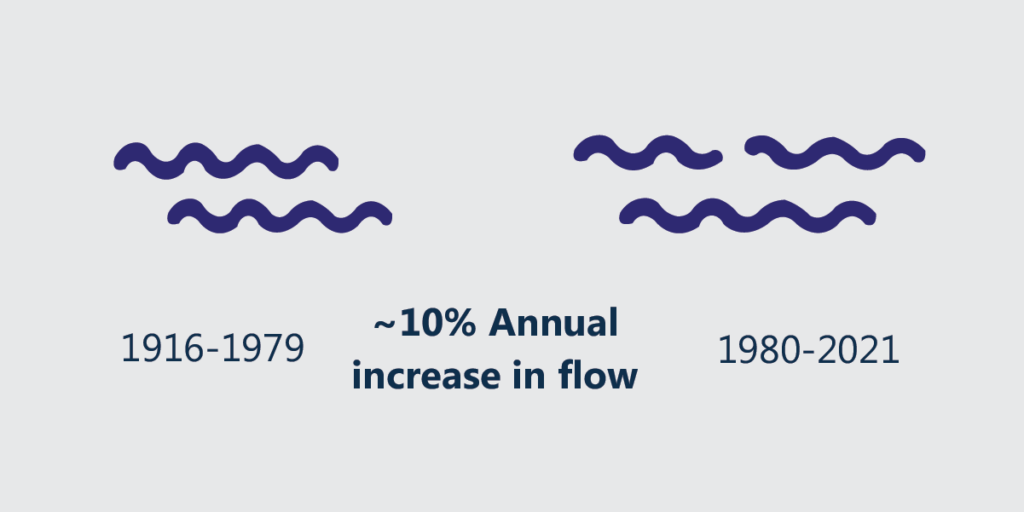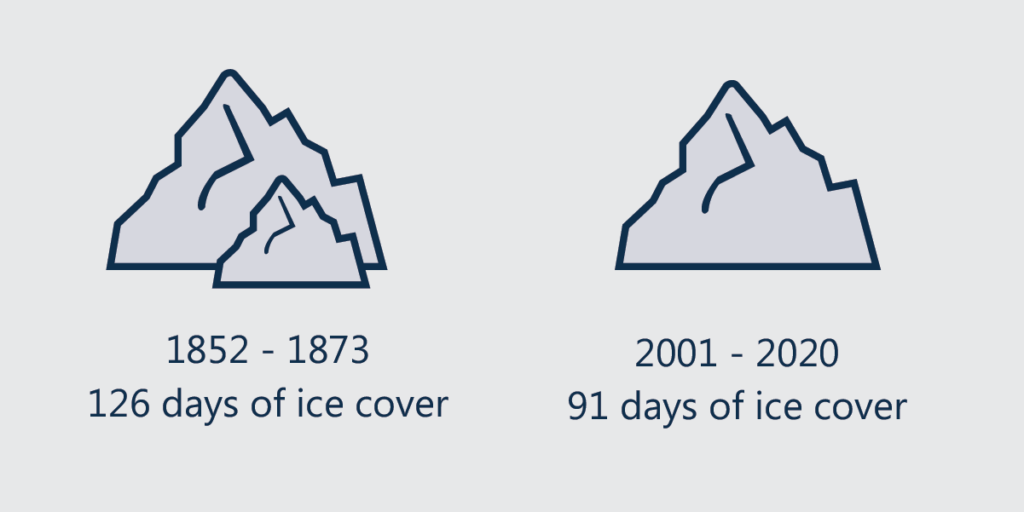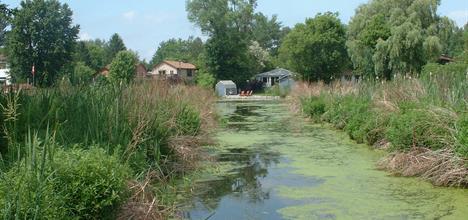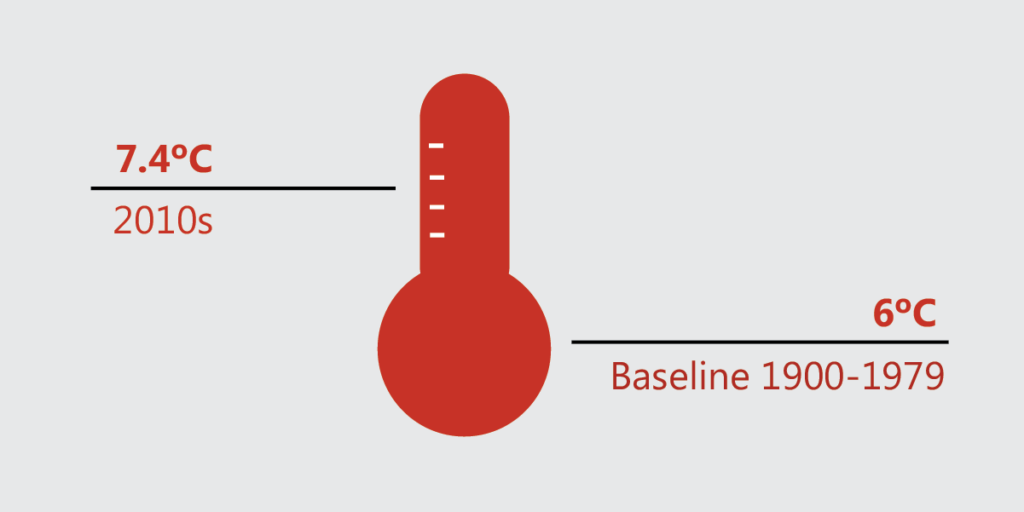Climate Change
Climate Change
Climate change, the long term change in Earth’s weather patterns – is one of the most pressing environmental and social issues of our time. A changing climate brings with it extreme heat, drought, flooding, more intense weather and storms, rising sea levels, and a host of other impacts that all contribute to enormous environmental, social and economic challenges.
Climate change is a global issue, but we’re also seeing changes locally.
In the Lake Simcoe watershed, climate change affects natural areas and wildlife, farming, urban areas, and the lake itself. In fact, there is clear evidence that climate change is underway, and is already affecting watershed function, including stream flow, precipitation, phosphorus loading, and the period of ice cover on Lake Simcoe.
Shorter ice season
That’s not just bad news for those who enjoy ice fishing.
A number of key lake processes are driven by lake temperature, which can have dramatic impacts on the cycling and distribution of oxygen and nutrients in the lake.
There are also a number of biological processes that are tied to annual changes in lake temperatures. Changes in lake ice could alter the timing of these temperature changes potentially causing predator/prey relationships to become decoupled. These changes also can lead to changes in dissolved oxygen in the lake in the following summer.
In recent years, the main basin of Lake Simcoe has remained as open water while the number of days with ice cover continued to decline on Kempenfelt Bay. It’s worth mentioning that the five years with the shortest ice cover occurred after the year 2000 and the five years with the longest ice cover occurred before 1900.
Seasonal changes in river and creek flow
We’re seeing less water flowing into our creeks and rivers in spring, and more flowing in winter. Biological processes in our streams and rivers are tied to seasonal water flows.
When low-flow periods get longer it can lead to increased water temperatures, degraded water quality, and reduced stream habitats and connectivity. At the other end of the spectrum, extreme flooding isn’t much better. It can increase erosion and flush nutrients and pollution into streams, increasing the water’s turbidity (murkiness). As climate change continues, both low-flow and flooding conditions are expected to increase.

More Phosphorus
The amount of phosphorus in the Lake is associated with the amount of run-off entering the Lake. And since climate change generally means more intense rainstorms, and more intense storms mean more run-off, we can expect increased amounts of phosphorus entering the Lake.
Climate change may also result in longer droughts which would bring down the phosphorus loads entering our lake. Wet years with high tributary flows tend to see high phosphorus loads while dry years with lower tributary flows tend to see lower phosphorus loads.
Changes in Air Temperatures
The average temperature of the earth is warming, and this is causing changes in our weather patterns, resulting in more frequent and intense weather events.
Based on Intergovernmental Panel on Climate Change (IPCC), the primary cause of the warming is a result of human activity, mainly, the burning of fossil fuels. For over a century there have been many factors, including increase in greenhouse gas emissions, and unsustainable energy and land use, that have led to global warming of 1.1 C above expected average.
Precipitation
Increased frequency and intensity of rain events, or more frequent snowmelt events, can affect all aspects of the water cycle and water movement through the watershed. Climate change is one of the many factors that affects precipitation patterns and can increase winter and spring precipitation, as well as the frequency, intensity, and duration of storms.
What we're doing
We’re addressing climate change in two key ways:
Mitigation
Mitigation is about reducing the amount of greenhouse gases that are causing climate change. Reducing greenhouse gases means decreasing the use of fossil fuels and promoting carbon capture (sequestering) through the protection and enhancement of natural areas such as forests.
Our Climate Mitigation Strategy identifies the main sources and sinks of greenhouse gases within the watershed. This overall understanding of the watershed’s carbon budget feeds into recommendations for how we can mitigate climate change.
We are also engaged in our own Carbon Reduction Strategy, a multi-year commitment to reducing our corporate carbon footprint by 28% by 2026. The good news is that we have achieved (and passed!) our corporate carbon reduction target in just five years!
Adaptation
Adaptation is about building resilience so that we can better prepare for the impacts of climate change such as extreme weather, drought and flooding.
Our Climate Change Adaptation Strategy reviews the potential impacts of a changing climate on watershed function and recommends changes to our programs and services to ensure they remain effective at protecting the Lake Simcoe watershed in projected future climates.
Other examples of how we are currently adapting to a changing climate are:
- Low impact development is one way we’re building resilience into the watershed. Low impact development is about adapting the way we build to help water mimic the natural process and go into the ground, not run-off into our waterways or overflow our infrastructure, leading to flooding.
- Our Phosphorus Offsetting Policy, which came into effect in January 2018, requires new development to control 100% of the phosphorus from leaving the property.
- Forestry – A comprehensive study to address the challenges faced to our forests as a result of climate change was completed in 2018. The study, “Adapting Forestry Programs for Climate Change” includes a list of climate-suitable species.
What can you do?
- Reduce use of fossil fuels and consider carpooling. Smart Commute can help you find a commuting partner.
- Use energy saving fixtures and appliances. Find more info at Hydro One
- Shop local. Look for items that have travelled less to make their way to you.
- Get a 72-hour emergency kit for power outages and weather related emergencies.
![]() Who to Contact
Who to Contact
Integrated Watershed Management
✆ 905-895-1281
✆ 1-800-465-0437 Toll free 
![]() Lake Simcoe Sessions Podcast
Lake Simcoe Sessions Podcast
Join us for an audio learning journey, where you will have the chance to hear how climate change is impacting us locally, here in the Lake Simcoe Region.




